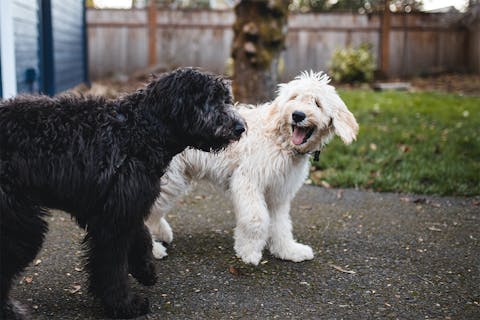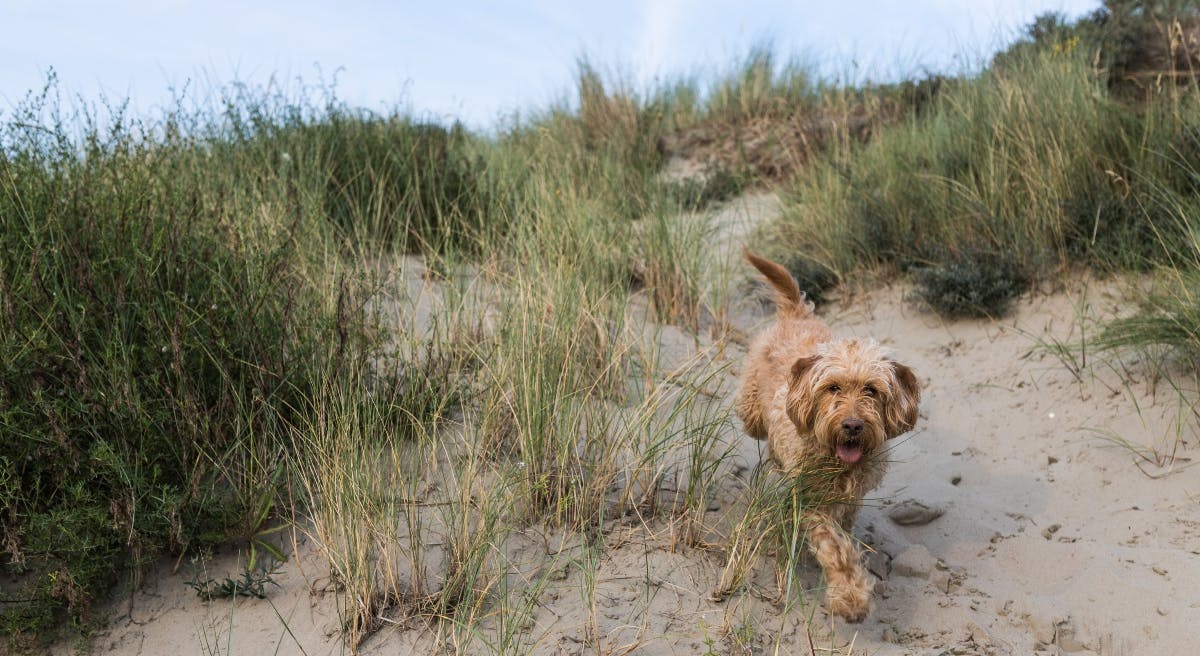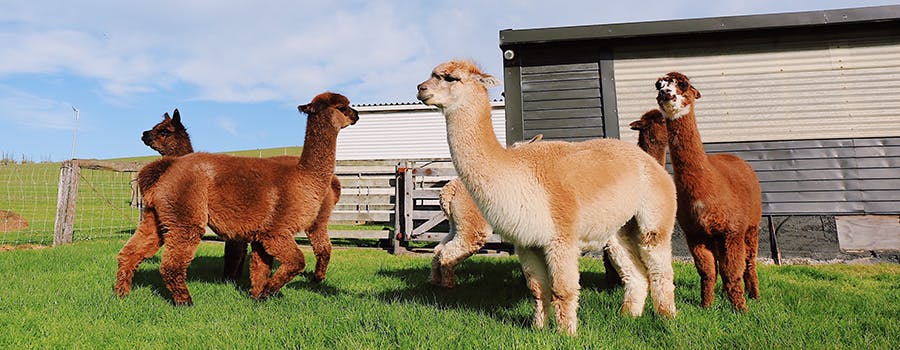Updated 18th August 2025
Want to learn how to crate train a dog, or thinking of crate training a puppy? Stay right where you are - below is a vet-approved guide to crate training your dog.
Find step-by-step instructions for crate training - from choosing the right crate to locking the door. Explore the benefits of crate training, along with vet-approved tips that’ll have your dog loving time in their new safe space.
Step 1: Pick the right crate for your dog
- Choose a crate that’s large enough for your dog to stand, turn around, and lie down comfortably.
- If your dog prefers quiet, enclosed places then a plastic crate will be best as it adds a sense of privacy.
- Wire crates are sturdy and they’re better for dogs who like to see their surroundings, or need more ventilation.
- Partially cover a wire crate with a blanket if they need more security or warmth.
- Soft-sided crates are a good option for travel because they’re more lightweight.
- Wooden crates are also available and can fit in with your home decor, but your dog may chew through it.
- Older dogs may suffer from arthritis or other mobility issues, so make sure their crate is super comfy, easy to get in and out of, and is in an accessible place.
Step 2: Make the crate comfortable and appealing for your dog
Now that you’ve chosen your crate, you need to teach your dog to love it. To start dog crate training, set up the crate while your dog is out of the room.
- Place the crate in a familiar, draft-free and low-traffic area that’s away from direct sunlight.
- Load up the crate with blankets, toys, and maybe some orthopedic bedding to support your older dog’s joints.
A crate filled with your pup’s favorite things will ensure your dog feels comfortable, and they'll start to view it as their safe space.
Step 3: Let them explore on their own and praise heavily
- Let your dog explore the crate freely with the door to the crate open.
- Use positive reinforcement to encourage your dog to go into the crate more often.
- Treats such as peanut butter, dog food, toys, and praise will help create positive associations with the crate and encourage your dog to enter.
- Once your dog enters the crate, praise them heavily.
- Go at your dog’s pace and keep the crate training sessions short to start with.
- Positive reinforcement is also especially important if you’re crate training a dog that’s older or from a rescue, as they may have negative feelings towards being inside a crate.
- Place treats in the crate when they aren’t looking so they associate the crate with positive things when you aren’t there.
If you need a little extra help making your dog feel comfortable about their crate, reach out to a vet or a certified dog behaviorist.
Trending posts
Purr-use some of the top blogs our members have been loving this month- Top male dog names for your new furry friendGot a new furry family member in your pack? Check…

- Top female dog names for your new fluffy palWelcoming a new pooch into your family? Explore…

- 250+ gray cat names your silver feline will loveRecently welcomed a fluffy gray bundle of joy into…

- What are normal pet sitting rates?Discover the average pet sitting rates for animals…

- Unique dog names to stand out from the packDare to be different with our list of the best…

Step 4: Close the door for short periods
Once your dog is comfortable going in and out of the crate, it’s time for the next step: closing the crate door.
- Give your dog a treat and start by closing the door for just a few seconds with your dog in the crate, and don’t lock it.
- Gradually extend the time and stick close by so they stay relaxed.
- If your dog reacts negatively to the door being closed, such as whining, barking, or panting, open it immediately. Take a step back and practice with the door open for a little bit longer.
Step 5: Gradually extend crate time
The next step of the crate training process is to desensitize your dog to extended time in the crate.
- By now your dog should be pretty comfortable with the crate itself.
- Increase the time in the crate gradually with the door locked, starting with a few minutes and slowly increasing the duration.
- Practice leaving the room while your dog is in their crate to help them adjust to being alone. Take a step back if they seem distressed.
- Crate training isn’t just for the home - practice crate training in the car by starting with short trips and gradually increasing the time spent in the crate during travel.
Things to keep in mind when extending crate time:
- If you increase the length of time too quickly, your dog might react negatively to being inside the crate.
- Always take small steps and increase the time slowly - starting with a much shorter time period.
- Avoid leaving your dog in the crate for more than three hours at a time.
Equipment you’ll need for crate training your dog:
- A crate that’s big enough for your dog to stand, lie down and turn around
- Comfortable dog bedding
- Dog blankets
- Treats and soft toys
The benefits of crate training your dog
Still unsure about getting your dog crate-trained? There are multiple benefits to crate training your dog, so take a look below to get clued-up on why you may want to consider incorporating a crate training schedule:
- Crates provide a safe space. A crate offers an environment where your dog can relax without getting into mischief. It’s especially useful during unsupervised times or busy household moments when they might want a calm sanctuary to retreat to. They’re also a great to have before you welcome a pet sitter, reminding your dog they’re safe and in their happy place while you’re away.
- Crates can be helpful for potty training. Puppies instinctively avoid doing their business in their sleeping area, making crates an effective tool for potty training.
- They can reduce separation anxiety. Gradual crate training can help puppies learn to enjoy their own company, reducing separation anxiety when left alone.
- Crates ease travel stress. Crate-trained dogs are often more comfortable during car rides and vet visits as the crate becomes a familiar and calming space wherever they are.
How to crate train a dog with separation anxiety
If your dog experiences separation anxiety, crate training your dog can help. Here are some tips on how to crate train an older dog or a puppy with anxiety:
- Add a personal touch. Place a blanket, a favorite toy or shirt with your scent into their crate to give them a familiar feeling.
- Create a calm atmosphere. Use anxiety toys, calming pheromone sprays, or relaxing background music to help keep your dog at ease.
- Take it slow. Go at an extra gentle pace with crate training, making sure every crate experience is positive. Lots of praise, treats, and patience will make all the difference and will build positive associations with alone time.
- Listen to your dog. If your dog starts barking or whining in the crate, it’s important to respond - otherwise, you may cause more issues in the long run. Slow down the training process, and do what you can to create a calm environment.
- Return calmly. Certified master dog trainer, Rob Kuty explains how to act when approaching your dog after their alone time:
“When a person has been away from their dog, especially if it’s been for hours, the human tends to feel bad and wants to make up the lost time.
They immediately shower their dog with an excited voice, touch and treats as they enter back into their dog’s life. This communicates a drastic difference between being with you and being without you.
It gives your dog the ability to realize being with you is so intense and exciting and being without you is the total opposite: boring, quiet and lonely.”
Make sure to seek help from a qualified behaviorist if you’re struggling to cope with your dog’s anxiety issues alone.
Useful resources
- Separation anxiety in dogs: how to calm an anxious dog
- Anxiety wraps for dogs: A gentle hug
- 6 dog anxiety vests to calm a nervous pooch
- 5 of the best dog toys for separation anxiety
- What can I give my dog for anxiety?
- Everything you need to know about cat separation anxiety
- Training a rescue dog: settling in & house training
- How to toilet train a puppy: a guide to puppy potty training
- How to house train an adult dog: bathroom training dogs
- 10 good dog training books on behavior and training
Meet our veterinary expert, Rebecca
This article has been checked by veterinarian Rebecca MacMillan, BVetMed MRCVS. Rebecca is a companion animal vet who has always had a passion for writing and client communication. Since her graduation from the Royal Veterinary college in 2009 she has gained a wealth of experience in first opinion small animal practice, in both clinical and managerial roles. She currently works in the South West and deals with a variety of routine and emergency appointments, but particularly enjoys medicine cases. Outside of work and writing, she enjoys spending time with her family, including her bouncy flat coated retriever George!
Looking for the perfect pet care for your precious pooch when you are away? With a TrustedHousesitters membership, you can choose from many caring and experienced pet sitters to take care of your dog in your own home.
Useful resources
How to crate train an older dog FAQs
What age is too late to crate train your dog?
It’s never too late to crate train a dog, as adult dogs can learn to use a crate with the right approach and patience.
Do adult dogs need crates?
While not all adult dogs need crates, many benefit from having a crate as a secure space, especially during travel, stressful events, or when unsupervised.
Do dogs prefer to sleep in a crate?
Many dogs enjoy sleeping in a crate as it offers them a cozy, den-like space that feels safe and secure.
Is it OK to put a dog in the crate when misbehaving?
No, the crate should never be used as punishment, as this can create negative associations and make the dog fearful of the crate.
How long should an older dog stay in the crate?
The recommended crate time for senior dogs varies depending on their needs. In general, dogs shouldn’t spend more than three hours at a time in the crate during the day, and they should always have regular opportunities for bathroom breaks, exercise, and social interaction.
How long does it take to crate train a puppy?
How long to crate train a puppy depends on their age, personality, and past experiences. With some consistency and patience, most puppies may take about 1–2 weeks to adjust to their crate, though some may need a little longer to settle in.
How can I get my dog to stop barking in the crate?
First, figure out what's causing the whining or barking – are they hungry, uncomfortable, or needing a bathroom break? Address the issue, calmly soothe your dog, and offer reassurance. You may need to pause puppy training and go back a few steps to where they feel comfortable in the training schedule if they’re feeling distressed.

